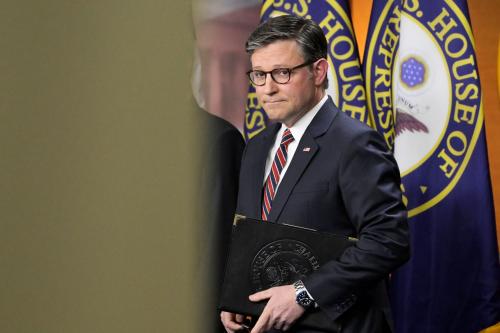On Monday, the justices of the United States Supreme Court will return from summer vacation a month early to hear four hours of oral argument on the constitutionality of the Bipartisan Campaign Reform Act of 2002 — commonly known as the McCain-Feingold law — the most significant reform of campaign finance laws in a quarter-century.
One of the central questions for the court is whether the law unfairly penalizes political parties. With its limits on so-called soft money, opponents say, it deprives the parties of the large gifts that used to come from companies, unions, advocacy groups and people that often were used to aid candidates. These donations were not subject to the “hard money” limits on gifts to a candidate or a party to help elect its candidates.
Opponents of reform have made this allegation a centerpiece of their case. As Kenneth Starr, the former independent counsel and a prominent critic of the law, has said: McCain-Feingold “threatens to balkanize American politics by empowering narrowly focused interest groups at the expense of political parties.”
This assertion, echoed in the briefs of the plaintiffs challenging the law, is just that — an assertion. The fund-raising figures from the first six months under the new law are just in, however, and they show that the assertion is flat-out wrong. Instead of withering away, the Democratic and Republican parties are thriving, adapting to the new system.
The fact is, politically involved Americans can still give a great deal of money to the national, state and local parties: the federal limit for one person is $95,000 per election cycle, including up to $25,000 per year to any national party. And the money is rolling in, thanks to the parties’ new fund-raising programs aimed at party activists, small-business owners, doctors, women and other groups. The National Republican Senatorial Committee has a new “presidential roundtable” that is hitting up those willing to give $5,000; the Democratic National Committee is putting together a centralized voter-contact and fund-raising system (proudly called “Demzilla”) to build its donor base among those able to give the maximum.
In the first six months of the 2004 election cycle (from Jan. 1, 2003, through the end of June), the national party committees raised $161 million — 45 percent more hard money than they received in the comparable 2002 cycle and some 50 percent more than in 2000. Indeed, the parties raised $23 million more in hard money in this period than they raised in hard and soft money combined in the first six months of the last presidential election cycle in 1999. Yes, the figure is some 25 percent less than the total of both hard- and soft-money donations of $213 million raised in the first six months of 2001. But in that year, 60 percent of the Democrats’ money and 40 percent of the Republicans’ revenues were in the form of the soft money that is now outlawed. On the whole, it is clear that the parties are already replacing the soft money that was “lost” as a result of McCain-Feingold.
Has the new law altered the balance between the parties? There is no doubt that the Republicans have been affected less: in the first six months of 2003, they raised $117 million, as compared to $79 million of hard money in the first six months of 2001, an increase of about 46 percent. The Democrats received $44 million, as opposed to $32 million in the first half of 2001, an increase of 38 percent.
But this disparity isn’t because of a flaw in the legislation. The Republicans have emphasized small-donor fund-raising, which has allowed them to build a broad base of donor support. In the 2002 election cycle, before McCain-Feingold was passed, the Republican National Committee attracted 500,000 new donors. And a new telemarketing program by the National Republican Congressional Committee has received contributions from 230,000 donors this year, helping it to raise $45 million ($7 million more than it had by this point in 2001, when it could raise both hard and soft money).
Democrats, apparently lulled in the 1990’s by the quick fix of soft money and the fund-raising prowess of President Bill Clinton, neglected that small donor base for years. However, Terry McAuliffe, chairman of the Democratic National Committee, has now vowed to increase party fund-raising by $100 million in 2004 to fill the gap. And in the first six months of this year the Democratic Congressional Campaign Committee added 33,000 donors; it says it will expand its donor base by 40 percent by the end of the year. In June, the committee raised $1 million in one month for the first time ever in an off-election year, signing up as many as 850 new donors a day.
And the current gap between the parties is actually smaller than it seems. According to the Democrats’ Congressional committee chairman, Representative Robert Matsui, it cost only $10 to $15 to recruit each new donor, as opposed to an estimated average of nearly $100 for the House Republicans. If true, this means the differential between the parties should really be adjusted in favor of the Democrats by some $10 million.
But no matter which party ends up dealing better with the new rules, there is no question that both are reacting impressively, and without the corrupting drug of unlimited soft money contributions. Parties, the heart and soul of the American political system, are amazingly adaptable. And as usual they are busy raising vast sums of money and expanding their bases and activities. This is a sign not of “balkanization,” but of health.
Norman Ornstein is a resident scholar at the American Enterprise Institute. Anthony Corrado is professor of government at Colby College and a scholar at the Brookings Institute.
The Brookings Institution is committed to quality, independence, and impact.
We are supported by a diverse array of funders. In line with our values and policies, each Brookings publication represents the sole views of its author(s).



Commentary
Op-ed“”Hard Money”” Is Easy to Come By
September 5, 2003